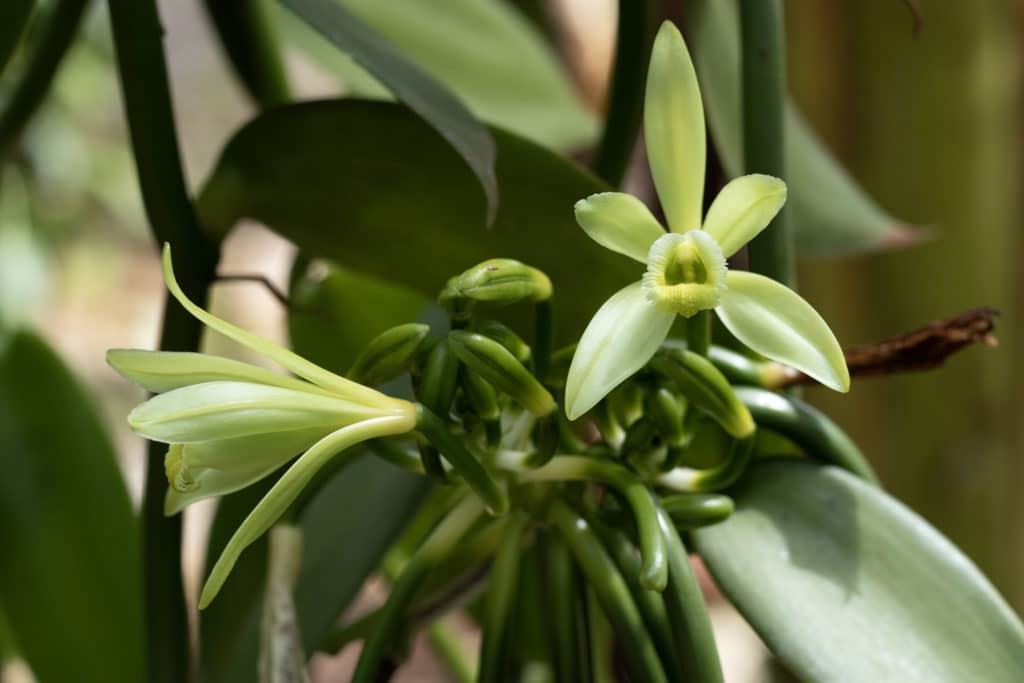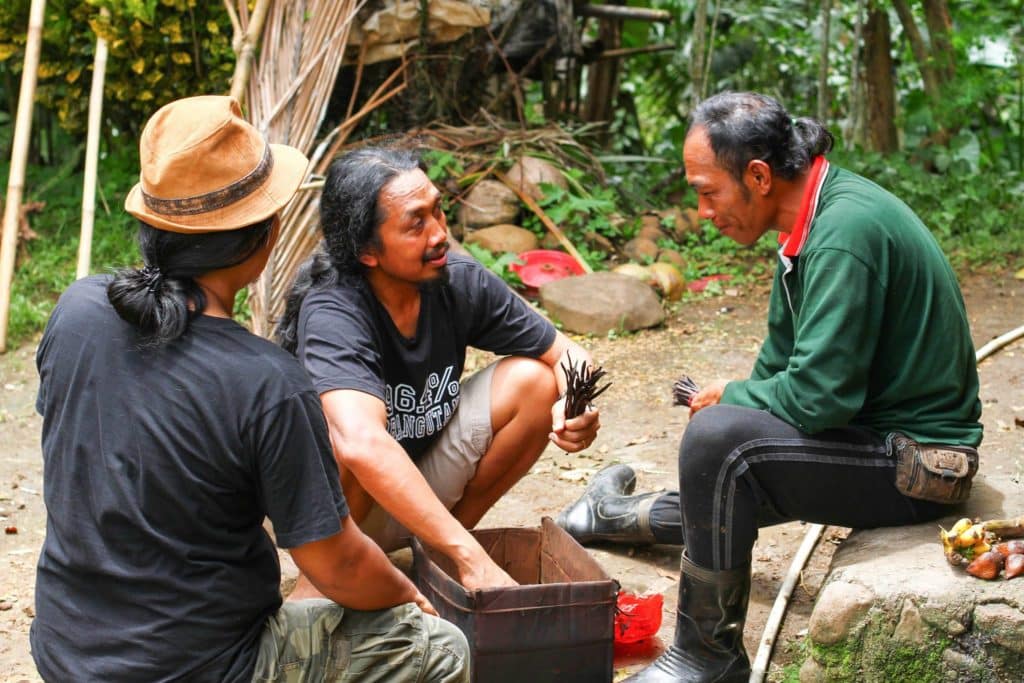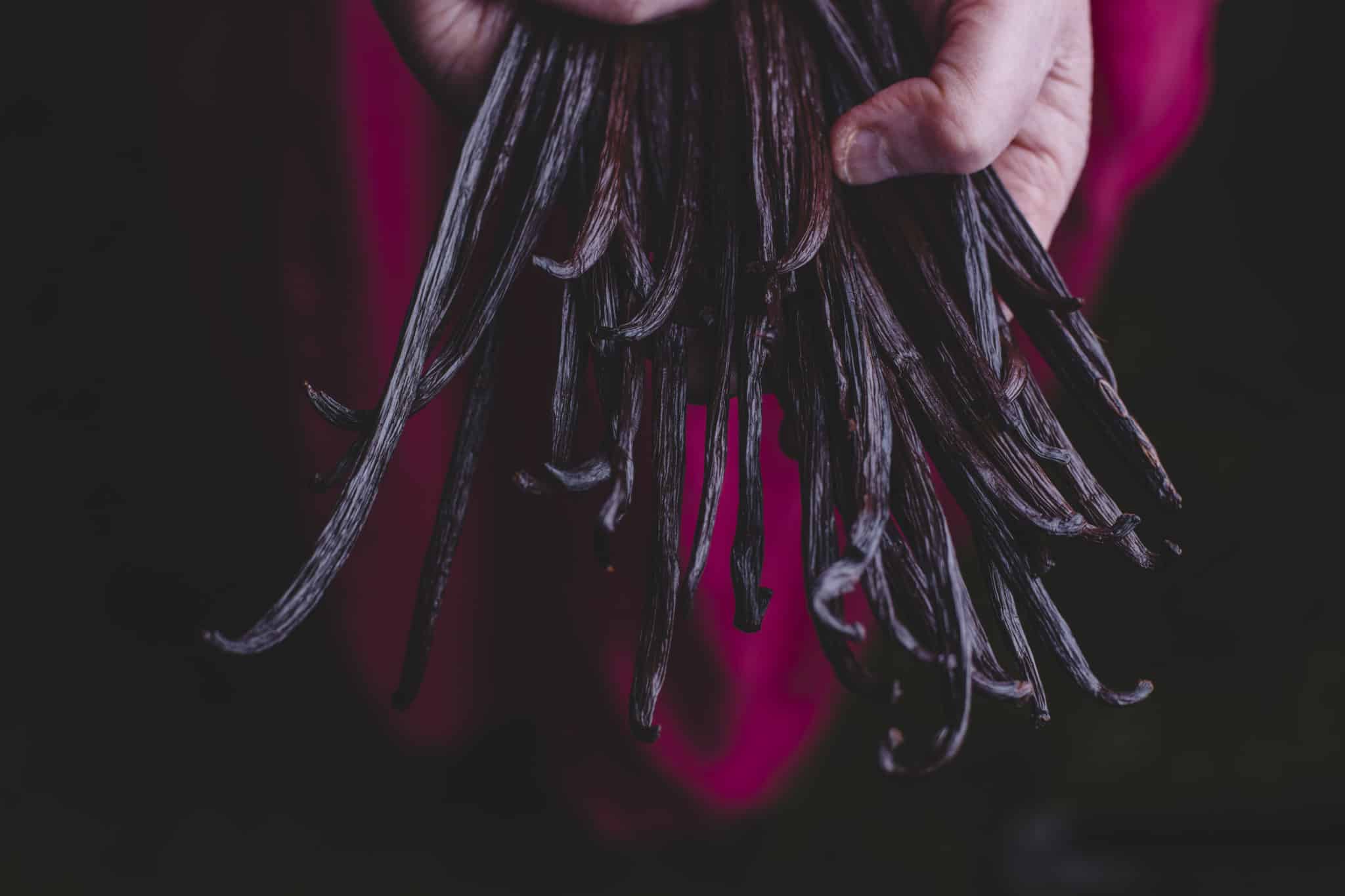The son of a spice farmer, Dr Made Setiawan now runs his own vanilla plantation as a cooperative community in Bali.
A decade ago, he began with just 3,000 seedlings, and now grows about 15,000 mature vanilla plants. Setiawan explains that because this crop isn’t a monoculture, it has potential to restore the land: “From a regenerative and agroforestry perspective, restoration and conservation cannot rely only on one crop. So when we talk about forests, vanilla is just one plant in the forest and it’s very versatile; it can truly be part of a polyculture system and it can grow on many types of trees,” he says.
Vanilla is an orchid – the only one to produce an edible seed pod – that grows as a climbing vine on other supporting trees. Out of 118 species of vanilla, just two of them, plus one hybrid, are cultivated throughout the tropics. Seedlings grow for more than three years before they start flowering.
Incredibly, each yellow vanilla flower blooms for just a few hours between October and January, and farmers hand pollinate the flowers to ensure a high pollination success rate. It takes another nine months for vanilla pods to mature, then pods are dried and conditioned once harvested the following summer.
Vanilla farming is slow, labour-intensive and sometimes dangerous. It’s the second most expensive spice in the world after saffron, so theft is a huge issue – many farms have armed guards and specific plantation locations remain undisclosed.
From a regenerative and agroforestry perspective, restoration and conservation cannot rely only on one crop. So when we talk about forests, vanilla is just one plant in the forest.
Setiawan, who previously worked as a professor of public health in Indonesia and now lives in Oxford, explains that more farmers are considering vanilla as ‘a welcome commodity’.
“For many farmers with lots of land in Borneo they want to grow palm oil [grown on destructive monocultures], but now more farmers with smaller plots of land, say two to three acres, are thinking vanilla is becoming an option.”

But a reliable, stable and fair price for farmers is needed to make this food system financially viable. Setiawan’s family had to throw away tonnes of green vanilla pods due to market crashes when he was a young child, simply because nobody was buying it.
So he collaborates with a British company called LittlePod, connecting farmers directly to the global market. This shortens the supply chain and guarantees consistency in quality and quantity of vanilla, while ensuring a fair wage.
“Vanilla is a high value commodity for the farmers but it’s a five year project for them,” says Janet Sawyer, founder of LittlePod, who explains that the ‘boom and bust’ cycle of the vanilla market makes it a difficult crop to grow, sell and profit from. “So [farmers] need to be certain that in the West we’re going to choose real vanilla.”
Since the 1970s, the flavouring vanillin has been artificially manufactured and now at least 97 per cent of the world’s vanilla is synthetically produced, not sourced from real vanilla plants. But with the right support and in the right locations, vanilla farmers like the ones working with Setiawan could be instrumental in forest regeneration.
This year, scientists at the University of Göttingen and the University of Antananarivo in Madagascar found that, when planted on fallow land that has previously been deforested, vanilla cultivation within an agroforestry system benefits both local communities and wildlife.

Oscar A. Perez Escobar, Sainsbury orchid fellow and research leader at Royal Botanic Gardens, Kew, agrees that “vanilla can indeed be part of agroforestry systems, but only as long as these systems do not involve their establishment in protected forest areas.”
Eighty per cent of vanilla is grown in Madagascar, and in addition to selling Indonesian-grown whole pods direct to chefs, Sawyer uses wonky pods of Madagascan vanilla that weren’t being sold easily to create an ‘everyday’ paste sold in tubes.
Before she set up LittlePod, chefs told her they were splitting and deseeding up to 300 pods a day, yet none of them knew vanilla came from an orchid. “They had lost touch with the story of vanilla, where it comes from and how it’s made,” says Sawyer, who set up International Real Vanilla Day on 17 October to raise awareness.
For many farmers with lots of land in Borneo they want to grow palm oil, but now more farmers with smaller plots of land are thinking vanilla is becoming an option.
Madagascar is one of the poorest countries in the world and one of the most vulnerable to the effects of the climate crisis. So on top of a volatile market for vanilla, this country has to contend with cyclones and droughts, and possibly the world’s first climate change-induced famine, according to the UN. Climate change threatens to disrupt the flowering patterns of the vanilla orchid too, says Escobar.
In light of that, LittlePod supports a marine conservation charity called Blue Ventures.
Dr Vik Mohan, Blue Ventures’ director of community health, explains the link between healthcare and conservation: “If you genuinely want farmers to engage in a cooperative activity where they have to plan long-term, to maintain and sustain a livelihood through vanilla for five, 10, 50 years, you have to address their basic needs.
“If their basic needs aren’t being met, they’re not able to live sustainably. That applies to the whole of Madagascar, including the vanilla-growing regions,” he says. “The impact of making vanilla sustainable and fair as a commodity could be massive because the people who are at the beginning of that [supply] chain are amongst the world’s most vulnerable.”









0 Comments